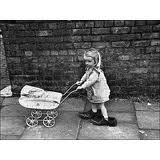
Emily Gallagher, a PhD student from the Australian National University, would like some help from our readers with her research into children's play in Australia pre-1950.
Very little has been written on this topic, a gap that Emily hopes to fill.
What follows is her detailed appeal for help - she will be very grateful for any and all contributions towards her research.
I am writing to ask for your help to find out what it was like growing up in Australia in the early decades of the twentieth century (1901-1939).
You might number among the generation who remembers ‘those days’, when children rode ponies to school, played at marbles on the street and dreamed of Shirley Temple. Perhaps you know of someone – a family friend or grandparent – who wrote recollections of their childhood. Or maybe there are old toys, scrapbooks, drawings, letters, postcards, school exercise books or family photographs tucked away in the attic or on the upper shelves of the living room bookcase.
Since I started searching for unpublished memoirs of Australian childhood late last year for my doctoral research, I have been intrigued by the extraordinary potential of family collections to enrich the history of children’s play and folklore. Even where public institutions might have overlooked the importance of such materials, families have recognised their significance, preserving stories and artefacts that are of immense value for historians and folklorists.
It is my hope that at least some of these family collections can be used to help provide insight into the lives and experiences of children growing up in  Australia before the outbreak of the Second World War in 1939. As children tiptoed to the toilet or lay awake at night, what monsters stalked their imagination? What secrets did they giggle or fight about with their friends and siblings? What kinds of games did they play with their dolls, meccano, toy cars and miniature soldiers? Where did children ride their billycarts (go-carts) and bicycles? What were the most popular skipping rhymes, slang, insults, jeers and jokes on the playground?
Australia before the outbreak of the Second World War in 1939. As children tiptoed to the toilet or lay awake at night, what monsters stalked their imagination? What secrets did they giggle or fight about with their friends and siblings? What kinds of games did they play with their dolls, meccano, toy cars and miniature soldiers? Where did children ride their billycarts (go-carts) and bicycles? What were the most popular skipping rhymes, slang, insults, jeers and jokes on the playground?
The 1920s and 1930s are still within living memory, but only just. If you are willing to contribute to this project by donating copies of materials or sharing your memories of growing up in Australia, please contact me via email, or mail (phone number available upon request).
Contact Details:
Email: This email address is being protected from spambots. You need JavaScript enabled to view it.
Mail: Emily Gallagher
School of History
Coombs Building
Australian National University
Canberra, ACT, 2601

